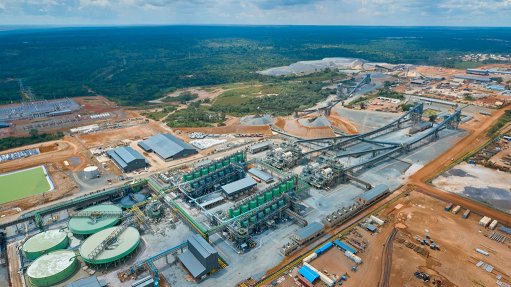
The Kamoa-Kakula mining complex
Canadian miner Ivanhoe Mines’ Kamoa-Kakula copper complex, in the Democratic Republic of Congo (DRC), sold 101 526 t of payable copper in the second quarter ended June 30 and recognised record quarterly revenue of $702-million and earnings before interest, taxes, depreciation and amortisation (Ebitda) of $457-million.
Ivanhoe recorded adjusted Ebitda of $172-million for the quarter, compared with $101-million for the same period in 2022.
Kamoa-Kakula’s quarterly cost of sales totalled $1.24/lb of payable copper, while C1 cash costs were $1.41/lb, at the lower end of guidance.
Ivanhoe recorded a profit of $87-million for the quarter, net of a $27-million non-cash loss on the $575-million convertible bond fair valuation, compared with a profit of $82-million for the previous quarter.
Since entering Phase 1 commercial production on July 1, 2021, the Kamoa-Kakula joint venture has generated $1.82-billion of net cash from operating activities, which has funded both the Phase 2 and Phase 3 expansions to date.
Ivanhoe has a strong balance sheet with cash and equivalents of $393-million on hand as at June 30, and expects Kamoa-Kakula’s Phase 1 and Phase 2 cash flow to be sufficient to fund the Phase 3 expansion capital cost requirements at current copper prices.
OPERATIONAL HIGHLIGHTS
Record quarterly production of 103 786 t of copper in concentrate was achieved at Kamoa-Kakula for the quarter, compared with 93 603 t in the previous quarter and 87 314 t in the previous year’s second quarter.
Over the first six months of the year, Kamoa-Kakula produced 197 389 t of copper in concentrate, placing it well on track to deliver yearly production guidance of between 390 000 t and 430 000 t of copper.
Kamoa-Kakula's Phase 1 and 2 concentrators milled a record 2.2-million tonnes of ore during the second quarter at an average feed grade of 5.2% copper. This included high-grade, run-of-mine ore from the Kakula mine, supplemented with ore from the surface stockpiles to achieve throughput higher than original design capacity.
Kamoa-Kakula's Phase 3 mine and concentrator expansion, 500 000 t/y on-site, direct-to-blister copper smelter and the refurbishment of Turbine No 5 at the Inga II hydroelectric facility are advancing on schedule and are expected to be complete in late 2024.
At current copper prices, it is expected that cash flow from Kamoa-Kakula’s Phase 1 and 2 operations will be sufficient to fund the remaining 2023 and 2024 expansion capital cost requirements of about $2.1-billion.
Ivanhoe continues its expansive copper exploration programme on its Western Foreland licences adjacent to Kamoa-Kakula. The 2023 exploration programme is budgeted at about $19-million.
A total of 37 holes and 10 853 m were completed during the quarter following the conclusion of the wet season in May. A total of 15 736 m of diamond core have been drilled in the first half of the year.
Ivanhoe is on schedule to publish a maiden mineral resource estimate for its Makoko and Kiala high-grade copper discoveries in the Western Foreland in the next quarter.
Ivanhoe is undertaking optimisation work to identify value-accretive options for installing hoisting capacity to Platreef's Shaft 3, which was originally planned as a ventilation and secondary escape shaft.
The additional hoisting capacity from Shaft 3 may be used to accelerate underground mining activities for Phase 2, in advance of the completion of Shaft 2, which is expected in 2027.
At the Kipushi zinc/copper/lead/germanium mine in the DRC, which the company is restarting, overall construction progress is about 50% complete and construction of the concentrator is on schedule for commissioning in the third quarter of 2024.
Kipushi's underground development activity is ahead of schedule, with 2 147 m of lateral development completed since September 2022.
Stoping of the ultrahigh-grade Big Zinc orebody is expected to begin in January 2024.
The year-to-date underground development rate averages about 250 m a month. The underground development rate is expected to increase to about 450 m a month by year-end.